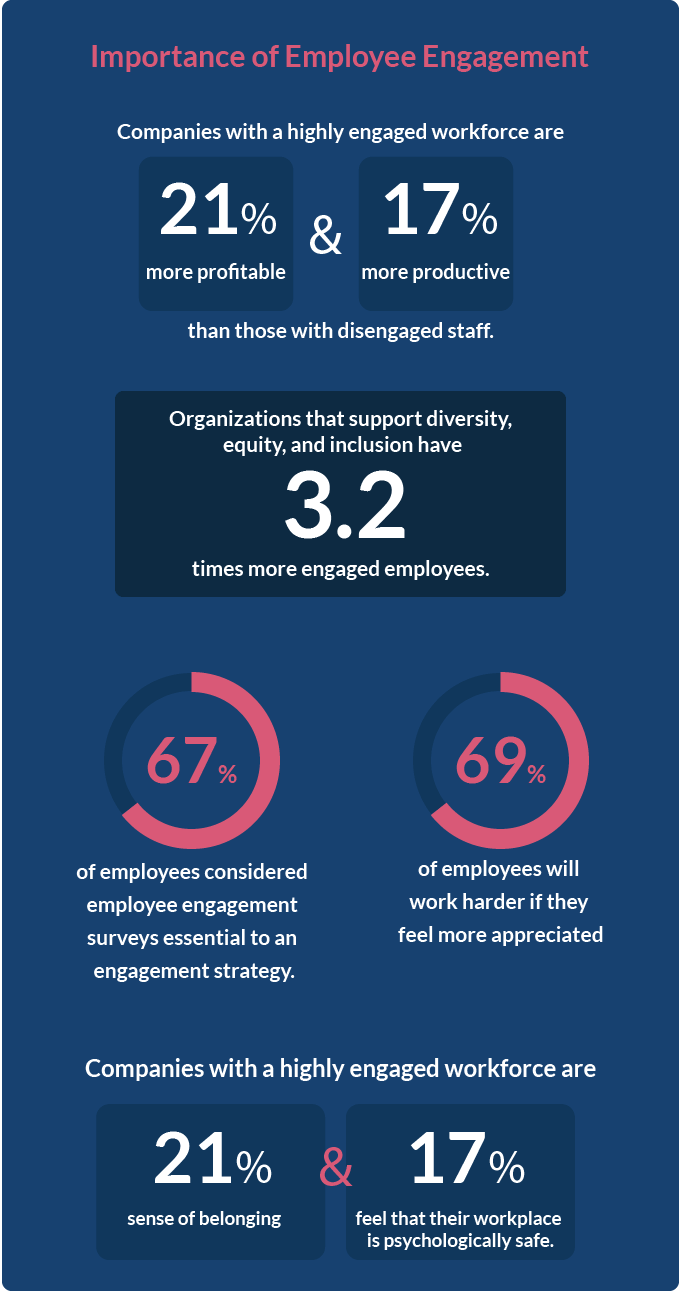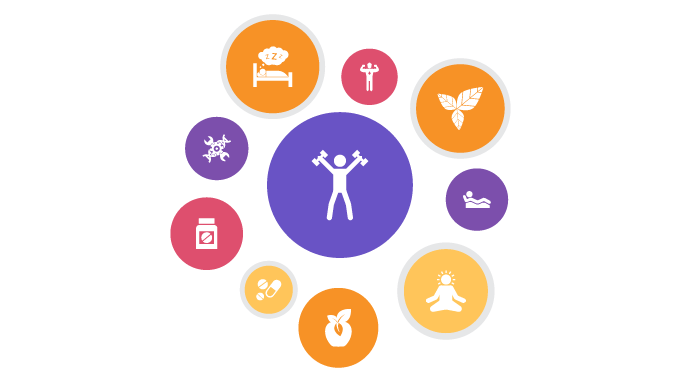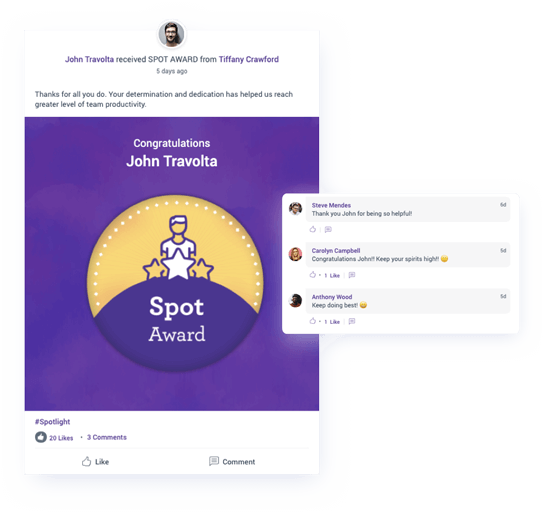Unlocking the 5Cs of Employee Engagement: A Pathway to Organizational Success
Employee engagement is not just a buzzword anymore. It has become a necessity in every organization that wishes to improve its work culture. And to effectively develop an engagement strategy, understanding the 5Cs of employee engagement is necessary.
These 5Cs represent the critical components that, when addressed and nurtured, can lead to a highly engaged workforce and pave the way for organizational triumph.
By diving into the depths of Connection, Communication, Collaboration, Congratulate, and Care, we will uncover actionable strategies and real-world examples that organizations can implement to unlock the full potential of their employees.
Key Takeaways
- You will learn about the crucial 5Cs that surround employee engagement.
- The importance of having a good employee engagement strategy.
- Understand the drivers of engagement.
But before we get into the detailed explanation of these 5Cs, it is critical to understand the importance of employee engagement and its drivers of it.
II. Importance of Employee Engagement
In today’s competitive landscape, the need for an effective employee engagement action plan has become significant. It is not a want anymore but a need that every organization must emphasize. Understanding the role of engagement in transforming a work culture into a good one is pivotal.
How is it important, though? Why employee engagement has become a fundamental part of evolving organizations in the past decade? We must look at a few statistics highlighting its growing significance to understand that.

1. It improves performance in the long run as the employees feel more connected with their work. Companies with a highly engaged workforce are 21% more profitable and 17% more productive than those with disengaged staff. These employees outperform their peers as they are more innovative and efficient.
2. Good employee engagement positively impacts the organization’s DEI efforts. Our Global Industry Report on the Impact of Employee Engagement Driving Diversity and Inclusion found that organizations that support diversity, equity, and inclusion have 3.2 times more engaged employees.
3. The big thing about having a good and concrete engagement plan is that it helps reduce employee turnover. One of the reasons is that it gives employees a sense of pride and value within the organization. And that is a very big deal. Especially in the present corporate world, which is fast-paced and demanding. According to a report, 67% of employees considered employee engagement surveys essential to an engagement strategy.
4. Another great thing about an engaged workforce is that they are less burned out. According to a report, they have a 30% sense of belonging, and 50% feel that their workplace is psychologically safe.
5. Recognizing and acknowledging an employee is important to employee engagement. Reports have shown that 69% of employees will work harder if they feel more appreciated, which is also true for us. You feel accomplished when someone from the team or your supervisor appreciates your work. And that is something that a good engagement plan does for you. Appreciation becomes an integral part of the work culture and creates a dynamic environment.
III. Drivers of Employee Engagement
Creating a culture that focuses on employee engagement is not an easy thing. It requires the right strategy and approach, which will make it effective. But apart from that, you need to understand the drivers that act as a catalyst to boost your engagement strategy.
What are these drivers? Let us have a look at it. We will mention the most prominent and significant ones, so you don’t hesitate to work on them.
1. Leadership

Engagement starts with good leadership and how you lead your people. People need to feel confident and comfortable around you. They can go above and beyond to achieve their goals once they bond well with a leader. Be mindful that to become a good leader, you must work on your leadership qualities and skills and become a people person.
2. Feedback and Recognition

Employees love receiving feedback about their work. It allows them to work on the weaker areas and improve themselves. At the same time, they also love the idea of getting recognized for a job well done. Hence, feedback and employee recognition are integral to employee engagement and work as a driver.
Be consistent with your feedback cycles and recognition process.
3. Meaningful Work

Employees should have a sense of purpose regarding their job responsibilities. They should feel connected to their work, contributing to the organization's greater good. It should also provide them with bigger career opportunities that help them improve their skill set. The more involved they are in their work, the higher their engagement levels in the workplace.
4. Benefits

Meaningful work or feedback alone won’t help you drive engagement. It needs more support, which can come in the form of employee benefits. Employees seek something more than just their salary. And with extra added benefits, you can motivate them to become more productive and allow them to enjoy the benefits simultaneously.
5. Employee Wellness

A mentally and physically sound employee is a productive employee. And as a leader, you must always keep this thing in mind. You must invest more in employee wellness and catering to their health needs. The idea is to help them reduce stress, minimize burnout, and increase their morale in the workplace.
6. Growth

Another essential factor that helps in driving engagement is the opportunity provided to the employees for their growth. Employees want to improve their learning curve both professionally and personally. They do not want to be stuck with a dead-end job. Instead, they want to feel confident that their job will help them in their career. And you being the leader, need to acknowledge that and provide them with ample opportunities to grow.
7. Work Environment

Understanding how the work environment plays its part in driving engagement is crucial. This driver's component refers to two distinct concepts: the level of physical safety employees feel while performing their job and their comfort level, including anything from lighting and ergonomic keyboards to accessibility features and design. And the level of psychological safety where employees are empowered to try out new ideas and become creative. As a leader, you must balance these two workplace concepts perfectly. If the equilibrium is disturbed, then engagement takes a big toll.
IV. Exploring the key components of the 5Cs and their impact on organizational success
Component 1: Connection

Creating meaningful relationships and bonds among employees starts with good connections in the workplace. When employees have good connections, it goes beyond just knowing each other. It creates a sense of camaraderie, trust, and understanding. Moreover, it fosters a positive work environment where people support each other. It is a crucial component when it comes to driving productivity and engagement. In the long run, it improves teamwork, collaboration, and satisfaction of employees.
Here are a few strategies through which you can encourage good connections between employees:
-
Invest in team-building activities such as group outings, workshops, or retreats.
-
Create good office common spaces like lounges where employees can converse casually.
-
Facilitate buddy programs or mentorship where you can pair new employees with experienced colleagues who can guide and support them.
A connected workforce is like a nerve system that works together and improves performance in the long run.
Component 2: Communication

Effective communication plays a crucial role in enhancing employee engagement. But for the communication to be effective, it has to be transparent, clear, and consistent. This creates a sense of trust and openness within the organization. Moreover, with good communication, employees are always in the loop about organizational developments, which makes them feel valued. In addition, when organizations focus on communication, they can set clear expectations for their employees and improve productivity.
But how can you develop concrete and good communication channels in your organization?
If that is something you are still unsure about, here is a list of a few ideas that you can refer to-
-
Having face-to-face communication to have complex discussions, sensitive matters, or when building personal connections.
-
Email for formal or detailed communication and documentation.
-
Instant messaging platforms for quick collaboration and coordination.
-
Video conferencing for remote or geographically dispersed teams.
-
Implementing tools for anonymous feedback or suggestion boxes that allow employees to share their thoughts without fear.
Furthermore, you can conduct regular team meetings, town halls, or feedback sessions to promote open communication. This will give the necessary voice to the employees where they can raise their concerns and receive updates from leadership. Also, encourage active listening so that you can address the concerns and work on solving them in the long run.
Component 3: Congratulate

Employees feel immense satisfaction and pride when their contributions are acknowledged and recognized. The contributions can include valuable ideas, efforts, and achievements individuals bring to the workplace. As a leader or a manager, you must take note of these and appreciate their contributions. Doing so makes them motivated and invested in their work. It gives meaning and a sense of purpose regarding their job responsibilities.
And to improve engagement, you need to encourage your employees to contribute more. The idea is to create a culture that values and welcomes diverse perspectives. To further increase participation, reward and recognize in every way possible the most valuable contributors.
Appreciation can come in various forms, such as public recognition, monetary or non-monetary rewards, unique badges, and much more. And to ease your efforts, you can opt for online cloud-based platforms to give the employees a unique experience. You can choose from a plethora of tools available in the marketplace.

One such tool is Vantage Circle’s Rewards and Recognition platform, which enables you to recognize it with its social recognition feature publicly. The fun part is that the entire workplace can engage in the social feed and use a wide range of badges, like the post, and comment with a goofy picture, which will help you improve engagement.
Component 4: Collaboration

A collaborative work environment is a critical part of a growing organization. Workplaces that collaborate well promote knowledge sharing, creativity, and innovation by leveraging diverse perspectives and skills. It also fosters a sense of ownership and collective responsibility while improving problem-solving and decision-making skills. One of the major advantages of a collaborative workforce is that individuals feel supported and valued, increasing engagement.
However, a leader must know how to develop a culture of collaboration. And here are a few strategies that will help you with it.
-
Establishing clear goals and objectives that require collaboration sets the foundation for collaboration.
-
Providing shared spaces where employees can easily interact with each other.
-
Creating a safe environment where active listening is done promptly, and diverse opinions are respected.
-
Facilitating opportunities for team-building activities, joint projects, or interdepartmental initiatives to boost collaborative mindset.
You can use tools such as Slack, Microsoft Teams, and Google Workspace to enhance your collaboration efforts in real-time further. These tools empower employees to collaborate efficiently regardless of their physical location.
Component 5: Care

Care in the workplace is an essential aspect of a healthy and thriving organizational culture. It encompasses a genuine concern for the well-being, personal growth, and success of one's colleagues. This means showing empathy, providing support, and going above and beyond one's professional duties to ensure things are in place. When you develop a culture of care, it fosters a positive work environment that promotes trust, loyalty, and commitment. In such workplaces employees genuinely feel cared for, become more engaged, motivated, and willing to reciprocate this care. In the long run, it enables you to make the employees feel valued and supported.
However, are you doing enough to create such a culture? It not, then here are a few strategies to demonstrate care for employees:
-
Providing a comprehensive employee assistance program(EAP) that offers counseling, wellness initiatives, and work-life balance.
-
Offering flexible work arrangements so that employees can cater to their personal needs.
-
Allowing employees to discuss challenges, growth opportunities, and individual goals openly.
-
Celebrating personal milestones, birthdays, or anniversaries.
You need to have a concrete plan to foster a culture of care in the workplace and enhance engagement in the long run.
V. Conclusion
Understanding the 5Cs of employee engagement has become crucial if a company wants to put a concrete strategy in place. A greater understanding of it will allow you to explore its various dynamics and use it more effectively. The important thing to remember is that it should not be limited to the top-down hierarchy. Everyone in the company should grasp it well enough to incorporate it into their daily lives.
The ultimate goal is to increase engagement and build a culture of recognition in the workplace.
FAQ
1. How can I improve employee engagement through Communication?
A. You can improve engagement through communication by regularly updating the developments with the workforce, acknowledge employee achievements, and encourage open feedback.
2. What is the role of connection in employee engagement?
A. The role of connection is very crucial when it come to employee engagement. It helps build strong relationships and fosters a sense of belonging among employees which enhances the team dynamics.
3. How can leaders foster a culture of Connection among remote teams?
A. Leaders can foster a culture of connection among remote team through virtual team-building activities and regular video conferences that help in relationship building.
4. How do the 5Cs of employee engagement help an organization?
A. The 5Cs of employee engagement can help an organization in various ways. Some of the include:
-
Improves performance.
-
Enhances an organization’s DEI efforts.
-
Reduces employee turnover.
-
Helps create a culture of appreciation.
5. What steps can organizations take to improve Employee Contribution?
A. There are a numerous ways through which organizations can improve employee contribution. Some of them are:
-
Offering skill development programs.
-
Delegating meaningful tasks.
-
Providing regular feedback.















